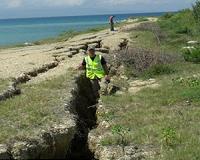| . |  |
. |
Seattle CA (SPX) Dec 15, 2010 Every 15 months or so, an unfelt earthquake occurs in western Washington and travels northward to Canada's Vancouver Island. The episode typically releases as much energy as a magnitude 6.5 earthquake, but it does so gradually over a month. New technology is letting University of Washington researchers get a much better picture of how these episodic tremor events relate to potentially catastrophic earthquakes, perhaps as powerful as magnitude 9, that occur every 300 to 500 years in the Cascadia subduction zone in western Washington, Oregon and British Columbia. "Depending on where the tremor is, a different part of the fault is being loaded," said Abhijit Ghosh, a UW doctoral student in Earth and space sciences, who is presenting the most recent findings at the annual meeting of the American Geophysical Union in San Francisco. Scientists discovered episodic tremor about a decade ago and have been trying to understand how it figures in the seismic hierarchy of the earthquake-prone Pacific Northwest. In 2008 on Washington's Olympic Peninsula, UW scientists deployed an array of 80 seismic sensors that act something like a radio antenna, except that instead of bringing in distant radio waves it collects signals from tremor events. Now there are eight such arrays, each armed with 20 to 30 sensors, a complex the scientists call the "array of arrays." It was known that tremor events generally start near Olympia, Wash., and march slowly northward on the Olympic Peninsula, eventually reaching Canada's Vancouver Island and running their course in several weeks. But Ghosh has found the tremor movement to be far more complex. The source of the tremor generates streaks that travel 60 miles per hour back and forth along a southwest-northeast track. Several hours of this activity produces what shows up as bands of tremor that steadily migrate northward at a much slower speed, about 6 miles per day. The effect is similar to someone painting a wall, with the wall representing the area where the tremor occurs and paint representing tremor streaks. Eventually the brush strokes will cover the wall. The arrays are producing enough data for scientists to locate the precise latitude and longitude where a signal originates, Ghosh said, but more work must be done to determine precise depths. It could be that the signal comes from the same depth, about 25 miles, as the subduction fault zone, but that is unclear. "Because the signal is very different from our garden variety earthquakes, we need new techniques to determine the source of the signal, and this is one step toward that," Ghosh said. "With the array of arrays we should be able to see a greater quantity of clear signal, and we do. We see more tremor - way more tremor - than with conventional methods." Researchers have known for several years that these tremor events add to the fault stress in the Cascadia subduction zone, where the Juan de Fuca tectonic plate dives beneath the North American plate that is directly under the most populous areas of Washington, Oregon and British Columbia. The last great Cascadia subduction zone earthquake, estimated at magnitude 9, occurred in January 1700 and generated a tsunami that traveled to Japan. The arrays are beginning to produce a better understanding of how tremor events are related to the Cascadia fault zone. For example, the southwest-northeast angle of the tremor streaks and bands matches almost exactly the angle, about 54 degrees, at which the Juan de Fuca plate meets the North American plate. "We have already seen different types of tremor migration in Cascadia, and there might be even more," Ghosh said. "With high-precision locating technology, we are getting a clearer picture."
Share This Article With Planet Earth
Related Links University of Washington Tectonic Science and News
 Assessing Seismic Hazard Of Central Eastern USA
Assessing Seismic Hazard Of Central Eastern USABlacksburg VA (SPX) Dec 13, 2010 As the U.S. policy makers renew emphasis on the use of nuclear energy in their efforts to reduce the country's oil dependence, other factors come into play. One concern of paramount importance is the seismic hazard at the site where nuclear reactors are located. Russell A. Green, associate professor of civil and environmental engineering at Virginia Tech, spent five years as an earthquake ... read more |
|
| The content herein, unless otherwise known to be public domain, are Copyright 1995-2010 - SpaceDaily. AFP and UPI Wire Stories are copyright Agence France-Presse and United Press International. ESA Portal Reports are copyright European Space Agency. All NASA sourced material is public domain. Additional copyrights may apply in whole or part to other bona fide parties. Advertising does not imply endorsement,agreement or approval of any opinions, statements or information provided by SpaceDaily on any Web page published or hosted by SpaceDaily. Privacy Statement |